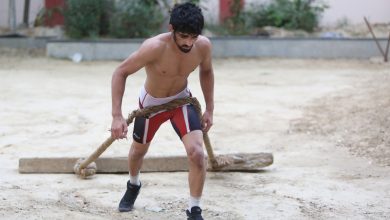India A look to make recce lessons count for bigger test

There was a moment during Pakistan’s visit to South Africa earlier this year when Misbah-ul-Haq’s eyes glazed over, his voice dropped and his shoulders slumped. It was not the instant his team was whitewashed in the Test series but about three weeks afterwards, when he had to explain why they had also lost the one-day series after fighting hard to lock it at 2-all. His reason was the same all summer and he seemed apologetic and even tired of saying it: the conditions were simply too difficult to adjust to.
It is a stereotype that South African pitches are to subcontinent batsmen what the moon is to people who prefer keeping their feet on the ground: uncomfortable. But it is also clich that continues to be perpetuated by team after team who visit these shores and struggle, usually everywhere except Durban. India and Pakistan have only won two Tests in South Africa and Sri Lanka have won one. None of these teams have ever won a series here.
With that record, it makes sense that India, who will compete against the No.1 ranked Test side later in the year, have sent an advance party to glean some knowledge of conditions and practise in them beforehand. India A’s squad included Cheteshwar Pujara, Rohit Sharma, Shikhar Dhawan, Murali Vijay and Ajinkya Rahane, all of whom can be expected to bat again here later in the year.
They will stay on to play two unofficial Tests against South Africa A following the 50-over tri-series which they won. Whether they will take back any valuable information at all is questionable because those matches are being played on flat, winter tracks that will not resemble the surfaces the mace will be defended on come December.
The cynics will see it as a plot: South Africa are trying to lure their opponents into a false sense of security by making their batsmen believe run-scoring will be easy. They can’t be blamed for seeing it that way. Vincent Barnes, high performance manager and coach of the A-side, is known for fighting talk against touring teams.
When Australia toured in late 2011, he said the practice game in Potchefstroom, played on a spicy wicket, was part of a plan to “rough up” the opposition. South Africa’s coaching brains trust have also made it clear that after a first-class season last year where pitches were so lively they felt it gave bowlers an enhanced sense of how good they were, they want more challenging strips this time around. But that is not what they are trying to do here.
Barnes himself was disappointed with the lifelessness of the pitch for the four-day match between South Africa A and Australia A. That fixture was a high-scoring draw in which David Warner earned his Ashes recall with 193, Glenn Maxwell made a case for Test selection with an unbeaten 155, Dean Elgar scored 268 to make a case to keep his Test place and Thami Tsolekile’s 159 would have put him back in the national selectors’ minds. There were only 18 wickets taken in two-and-a-half innings and neither attack managed to bowl the other line-up out.
The second match, which was played in Rustenburg, took place on what offspinner Simon Harmer described as a “good four-day wicket” because it deteriorated enough to bring the spinners into play. South Africa A won that match after Harmer took 8 for 87. While Barnes would not want a turning track against India but he would like something with a bit more bounce, which would be difficult to get at this time of year.
Up-country, it is dry throughout the winter and the lack of moisture makes for road-resembling pitches. For any life, cricket should be played at the coast. Durban would have been the most likely venue, with a tropical climate that is almost unaffected by the cold the rest of the country is gripped in.
Last year, South Africa A hosted Sri Lanka A there and bowlers had more success. Ryan McLaren led the wicket-tally with 11 wickets while Kosala Kulasekera also enjoyed conditions with six scalps in the series. This year, however, the A matches were not played in Durban for financial reasons.
Cricket South Africa have a partnership with the High Performance Centre in Pretoria, from where they also run their academy. The A-team can camp there without incurring much cost although both touring teams would have had to be put up at hotels. The cost-saving would be minimal but all teams would have benefited from the facilities in Pretoria, which are considered world-class. Zambia and Argentina’s football squads have set up bases there in the past.
Corrie van Zyl, the former national coach, heads activities at the Centre and his passion for developing it into a go-to place for cricket coaching is obvious. In his address after the final, van Zyl was sincere in thanking every member from the change-room attendant to the scorers for working on the A tournament. He said all the teams had been able to learn from each other and revealed the triangular tournament would become an annual event which will be played in Australia next year.
Perhaps that was the only point of it, after all. The three boards already have other interests together such as their shareholding in the Champions League T20 and this could be a furthering of that relationship. As it stands, the A-team tournament is not a money-making venture. The games are not televised and its purpose is to foster competition and expose players to counterparts of a similar calibre: those who have dabbled in or are ready to make the step up to international cricket.
But that should not be confused with what India A’s purpose to South Africa was: preparation for their upcoming tour. At least Pujara knows that. He said he expects a “huge difference” in conditions but that India A could learn about things like the weather instead. Perhaps someone should inform him that the weather, too, will be vastly different. After all, it will be summer in South Africa then.
Or perhaps, India A are hopeful their mission can still be fulfilled in the four-day matches. Justin Ontong, the South Africa A captain, joked that he would ask the groundsman to leave some grass on the pitch for the unofficial Tests but whether that would result in surfaces which foster a more even competition between bat and ball cannot be guaranteed.
Seasonal challenges may simply not sustain that. As a result, while there is a lot of merit in doing a recce trip, it’s unlikely it will give India any advantage when they return for the real deal.







